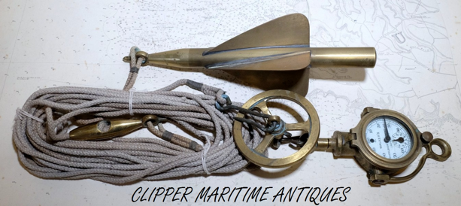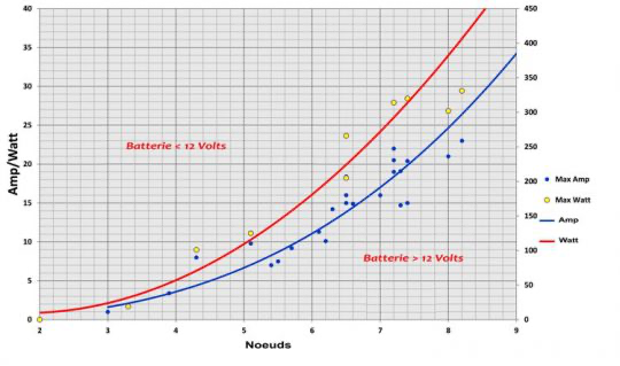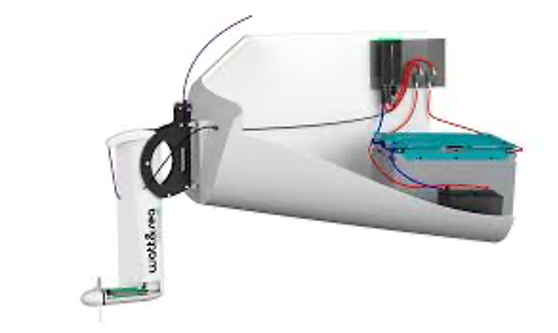In last week’s blog we discussed the alternator-to-prop shaft as the good old way to generate your energy from the waterflow under your sailing ship. But there are more options. Here we discuss the towing options. It is great fun to see them working behind your ship. But are they useful for us cruisers?
A separate towing hydro generator
The general principle of a towing generator is simple: you connect the one end of a line to a propeller, and the other end to the shaft of an alternator. You throw the propeller overboard and when the line stretches, the prop starts rotating, thus rotating the line, and rotating your alternator. When the line is long enough, it evens out the difference of speed the boat has when climbing a wave, versus it gliding down the wave.

The yield and efficiency
Just as with any propeller, the physics, precisely defined in Betz’s law , also apply for the towing props. With the right propeller and alternator, and in normal, not turbulent, water, they start delivering from 4-4,5 knots. In the beginning, the yield is poor, just some Watts. The real yield starts from 5 knots and the yield grows steeply with every extra knot.

When making a lot of speed, the line will stretch, so it will be higher in the water. The closer to the surface, the less efficiency. This is because the waves cause turbulence in the surface; it gets even worse when the prop sprays water up into the air.
Another factor is the speed differences, that will tangle the line. The speed differs with every wave: climbing to the wave top the yacht slows down, and from the top down, she speeds up. When the speed slows down, there will be more slack in the line, so it can tangle. You can prevent this by using a (stainless) steel line, or an anti-torsion line. This is not cheap, especially the latter one. And both are difficult to coil up, so it will take a lot of storage space.
The Duogen is a special thing: this is a wind generator and a hydro generator. You simply change the wind blades for a propeller and let the pole go into the water from the aft of your yacht. The pole is perhaps too short for an effective wind generation (I would recommend at least 5,5, meter high, see here). But the pole is long enough to keep a small angle with the water flow, small enough not to affect the efficiency that much. It may not work as well as a long towing line, even though the length of the pole helps a bit to equalize the speed differences before and after the top of a wave.
When using the right propellor, the energy yield is a bit less than the oldfashioned alternator-on-prop-shaft. But it is not much more than 10% less.
Towing propeller on the transom
You can also mount a towing propellor on the transom of your yacht. There are many brands on the market. The three main manufacturers (Wattt&Sea, Eclectic Energy and Save Marine) make transom towing prop units that can deliver up to half a kilowatt. If you pick the right propeller. For a cruising yacht of 35-45 feet, the best is a big (40-50 cm) diameter, and a small pitch. Racing yachts can do with the small prop and a higher pitch.

The mounting needs serious attention. First, always choose the deeper one, because it runs on laminar flow, and not on turbulent ‘flow’.
- close to the surface there is more turbulence, so less yield;
- you’d better keep it as far as you can from the turbulent water flow leaving the hull of your ship;
- the prop must be really deep when you sail in steeper waves: mounted on the aft, the prop can come out of the water. If it does, it costs you much yield;
- don’t mount it in the ‘flow-shadow’ of your rudder or your existing propeller(s), because there is serious turbulence.
These deeper transom towing propellers weigh about 15 kg. Their cut-in is at 4 to 4,5 knots, just as any propeller (Betz’s law) and they can deliver 500 to 600 Watt at a speed of about 8 knots. The racing unit is smaller and can deliver more. They cost about 4000 Euros. With some wiring, adjusting to your battery management and the installation hours, it will be 4500-5000 Euro.
Towing generators – great for ocean racers
Towing generators are fun, for sure. But it is difficult to get a good yield out of it. It lies rather high near the surface. The long rope can tangle, which gives extra drag.
The Duogen, the prop on the pole with a hinge on the aft deck, deals with this problem sufficiently. But it is more vulnerable in heavier weather. The hinge must be very strong, and the weight is considerable if you want to hoist it out of the water with 6 or 7 Beaufort.
The towing generator on the transom is not logical to me. We need laminar flow, and especially directly at the transom is the most turbulence, from the hull of the ship and from the propeller(s) you just stopped.
The question is, why would you first stop the propeller(s) on your sailing yacht and then put another propeller overboard? Note that the propeller you just stopped, is usually of the right size and pitch just for your ship, and located deep, so in a laminar flow. A towing generator on board a sailing cruiser just makes no common sense.
And you pay nearly 5000 Euros for it. If I would like to spend money, I would prefer a mechanic in my engine room just making the alternator to the propeller shaft (see this article ), it will be three or even four times cheaper. OK, the towing generator misses the resistance of the V-belt, but no doubt that this will easily be made good by the better location of your propeller.
The towing generator only makes sense for ocean racers, simply because they don’t have a prop at all (to save drag!).
If you have the extra 5000 Euro to spend, and you reconsider to buy a new engine, then consider an electric engine/alternator. This, including the batteries and all, is cheaper on the long run, and can even be cheaper in the first investment. This is a sophisticated system and straight forward to a maximum yield. Like the Ya has. Next week we discuss this.
